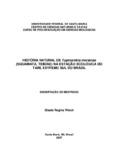| dc.creator | Winck, Gisele Regina | |
| dc.date.accessioned | 2009-03-11 | |
| dc.date.available | 2009-03-11 | |
| dc.date.issued | 2007-02-13 | |
| dc.identifier.citation | WINCK, Gisele Regina. Natural history of Tupinambis merianae (Squamata, Teiidae) in Taim Ecological Station, southern Brazil. 2007. 59 f. Dissertação (Mestrado em Ciências Biológicas) - Universidade Federal de Santa Maria, Santa Maria, 2007. | por |
| dc.identifier.uri | http://repositorio.ufsm.br/handle/1/11174 | |
| dc.description.abstract | The genera Tupinambis comprises the largest lizards of America, which could
reach 500 mm of corporal length. Two species possess wide distribution in South
America (T. teguixin and T. merianae), while the others are restricted the specific biome
(Amazonian Forest, Savannah and Chaco). The species T. merianae have the widest
distribution of the gender, from the south of the Amazonian Forest to the north of
Patagonia, at the east of Andes. In the present study, 640 h of sampling were
accomplished (320 h of observations in the area to analyses of behavior; 320 h of
observation along transects), in the total of 64 days. In the summer, there were no
registrations of active lizards before 7:37 in the morning, nor after 17:43 of the
afternoon. The use of community hibernacula was registered for the winter dormancy,
being the burrows dug in cemented constructions used more frequently in the
observation area. As for the seasonal activity, the first individuals emerged in August
and the last ones returned to the dormancy in April. The emergency of the population
demonstrated to be protandric, with adults emerging before juvenile. In the period after
emergency, the males were basking in aggregations of up to 13 individuals, which
changed of positions through audible resonant signs. Besides, sibilated sounds can be
emitted in stress situations or agonistic interactions. There was significant difference of
activity among the different certain periods in this study, along the months (F = 16.6; p
<0.01), being October and December the months with registration of the individuals'
larger activity. There was fluctuation in the population size and in the activity of the
different age classes along the months. The minimum home range for three males and
two females (variation from 0.05 to 20.29) were registered. The area of use of the
animals did not differ along the months, but it was possible to observe gregarious
behavior during the nine months of study. | eng |
| dc.description.sponsorship | Coordenação de Aperfeiçoamento de Pessoal de Nível Superior | |
| dc.format | application/pdf | por |
| dc.language | por | por |
| dc.publisher | Universidade Federal de Santa Maria | por |
| dc.rights | Acesso Aberto | por |
| dc.subject | Squamata | por |
| dc.subject | Tupinambis | por |
| dc.subject | Atividade | por |
| dc.subject | Área de vida | por |
| dc.subject | Sul do Brasil | por |
| dc.subject | Squamata | eng |
| dc.subject | Tupinambis | eng |
| dc.subject | Activity | eng |
| dc.subject | Home-range | eng |
| dc.subject | Southern Brazil | eng |
| dc.title | História natural de Tupinambis merianae (Squamata, Teiidae) na Estação Ecológica do Taim, extremo sul do Brasil | por |
| dc.title.alternative | Natural history of Tupinambis merianae (Squamata, Teiidae) in Taim Ecological Station, southern Brazil | eng |
| dc.type | Dissertação | por |
| dc.description.resumo | No gênero Tupinambis estão representados os maiores sáurios das Américas,
podendo atingir 500 mm de comprimento corporal. Duas espécies possuem ampla
distribuição na América do Sul (T. teguixin e T. merianae), enquanto as demais são
restritas a biomas específicos (Floresta Amazônica, Cerrado e Chaco). A espécie T.
merianae possui a distribuição mais ampla do gênero, ocorrendo do sul da Amazônia
ao norte da Patagônia, ao leste dos Andes. No presente estudo foram realizadas 640 h
de amostragem (320 h de observações na área de análises de atos comportamentais;
320 h de observação ao longo de transectos), no total de 64 dias. No verão, não houve
registros de lagartos ativos antes das 7:37 da manhã, nem após 17:43 da tarde. Foi
registrada a utilização de hibernáculos comunitários para a dormência de inverno,
sendo as tocas escavadas em artefatos de concreto, utilizadas com maior freqüência na
área de observação. Quanto à atividade sazonal, os primeiros indivíduos emergiram em
agosto e os últimos retornaram à dormência em abril. A emergência da população
demonstrou ser protândrica, com adultos emergindo antes dos juvenis. No período pósemergência,
os machos termorregularam em agregações de até 13 indivíduos, os quais
trocavam de posições através de sinais sonoros audíveis. Além disso, sons sibilares
podem ser emitidos em situações de stress ou interações agonísticas. Houve diferença
significativa de atividade entre os diferentes períodos determinados neste estudo, ao
longo dos meses (F = 16.6; p < 0.01), sendo outubro e dezembro os meses com
registro de maior atividade dos indivíduos. Foi registrada flutuação no tamanho
populacional e na atividade das diferentes classes etárias ao longo dos meses. A área
mínima de vida para três machos e duas fêmeas (variação de 0.05 a 20.29) é
apresentada. A área de utilização dos animais não diferiu ao longo dos meses e foi
possível observar comportamento gregário durante os nove meses de estudo. | por |
| dc.contributor.advisor1 | Cechin, Sonia Zanini | |
| dc.contributor.advisor1Lattes | http://lattes.cnpq.br/9682463613649812 | por |
| dc.contributor.referee1 | Colli, Guarino Rinaldi | |
| dc.contributor.referee1Lattes | http://lattes.cnpq.br/2272000258230548 | por |
| dc.contributor.referee2 | Cappellari, Lize Helena | |
| dc.contributor.referee2Lattes | http://lattes.cnpq.br/6026653879463126 | por |
| dc.creator.Lattes | http://lattes.cnpq.br/5464165599590932 | por |
| dc.publisher.country | BR | por |
| dc.publisher.department | Bioquímica | por |
| dc.publisher.initials | UFSM | por |
| dc.publisher.program | Programa de Pós-Graduação em Ciências Biológicas: Bioquímica Toxicológica | por |
| dc.subject.cnpq | CNPQ::CIENCIAS BIOLOGICAS::BIOQUIMICA | por |


